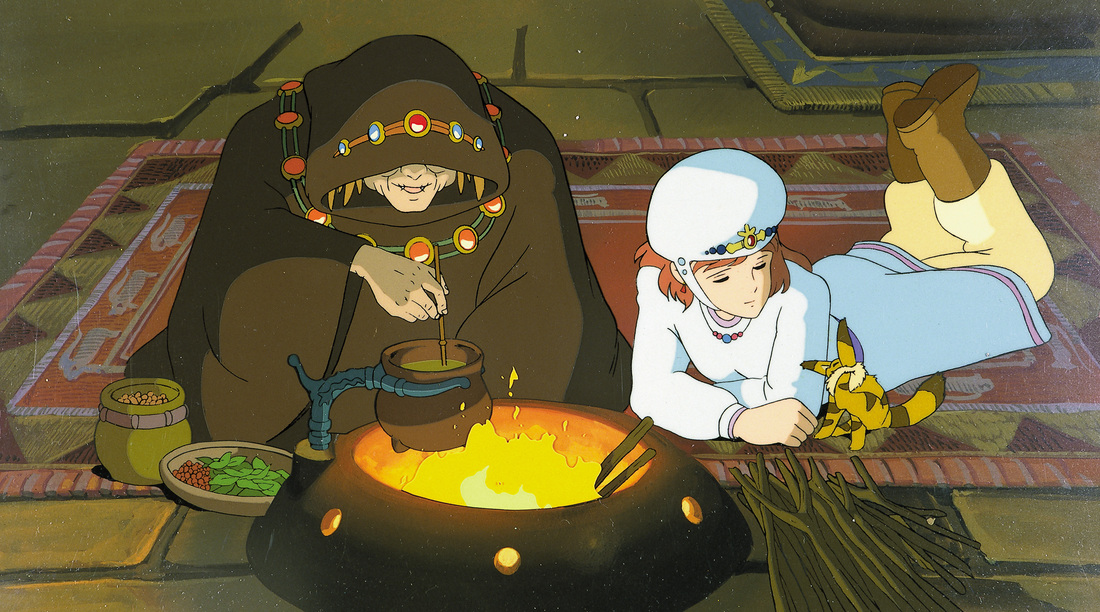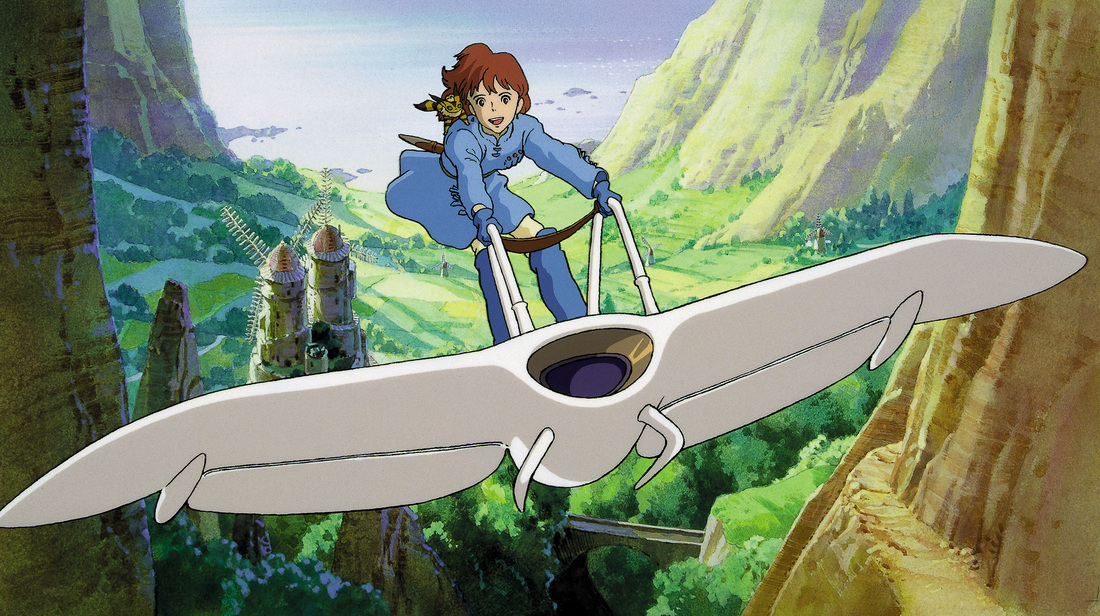|
How entertaining? ★★★☆☆
Thought provoking? ★★☆☆☆ 24 August 2007
This article is a review of NAUSICAA OF THE VALLEY OF THE WIND. |
“Yet another village is dead,” Lord Yupa (Patrick Stewart)
In 1984 Hayao Miyazaki’s second film was released, and led to the creation of the landmark Studio Ghibli. Initially NAUSICAA OF THE VALLEY OF THE WIND could not find financial backing, so Miyazaki created a manga series which proved successful and thus paved way the way for this feature-length animation. After, he became for me the greatest animation director of all time (MY NEIGHBOUR TOTORO, PORCO ROSSO, SPIRITED AWAY and CASTLE IN THE SKY to name a few).
NAUSICAA OF THE VALLEY OF THE WIND is a sci-fi epic warning against the dangers of damage to the environment, a theme continued later in Miyazaki’s PRINCESS MONONOKE. Opening on Lord Yupa, who rides a dodo-like creature, he visits a village evacuated or decimated, but either way the cause is the toxic jungle. It threatens the human race, in a perilous state for the last 1000 years since the collapse of the industrialised world. People have to wear masks to shield themselves from the lethal poisons in the air emanating from the spores in the jungle. The dodo is an interesting choice, an extinct animal, made so by people, and now the same species that caused that extinction are facing the same fate.
“A perfect Ohmu shell,” Nausicaa. Cutting to Nausicaa in the jungle foraging and investigating, we get a glimpse of the giant forestation that now exists, and is overwhelming humankind. Nausicaa is curious, compassionate, fearless and acrobatic, and has a power over sentient creatures to soothe them and maybe more. An Ohmu is a new kind of massive insect (similar to the ones in STARSHIP TROOPERS) that guard the jungle, and if riled by humans will attack with devastating consequences.
In 1984 Hayao Miyazaki’s second film was released, and led to the creation of the landmark Studio Ghibli. Initially NAUSICAA OF THE VALLEY OF THE WIND could not find financial backing, so Miyazaki created a manga series which proved successful and thus paved way the way for this feature-length animation. After, he became for me the greatest animation director of all time (MY NEIGHBOUR TOTORO, PORCO ROSSO, SPIRITED AWAY and CASTLE IN THE SKY to name a few).
NAUSICAA OF THE VALLEY OF THE WIND is a sci-fi epic warning against the dangers of damage to the environment, a theme continued later in Miyazaki’s PRINCESS MONONOKE. Opening on Lord Yupa, who rides a dodo-like creature, he visits a village evacuated or decimated, but either way the cause is the toxic jungle. It threatens the human race, in a perilous state for the last 1000 years since the collapse of the industrialised world. People have to wear masks to shield themselves from the lethal poisons in the air emanating from the spores in the jungle. The dodo is an interesting choice, an extinct animal, made so by people, and now the same species that caused that extinction are facing the same fate.
“A perfect Ohmu shell,” Nausicaa. Cutting to Nausicaa in the jungle foraging and investigating, we get a glimpse of the giant forestation that now exists, and is overwhelming humankind. Nausicaa is curious, compassionate, fearless and acrobatic, and has a power over sentient creatures to soothe them and maybe more. An Ohmu is a new kind of massive insect (similar to the ones in STARSHIP TROOPERS) that guard the jungle, and if riled by humans will attack with devastating consequences.
|
|
|
Hearing gun fire and then an Ohmu attack Nausicaa, riding her unusual glider, rescues Lord Yupa from almost imminent death. She takes him back to her village in the Valley of the Wind, where it is revealed she is a princess. The village is a relative paradise because the winds from the sea protect the citizens from the spores that travel in the air from the burgeoning jungle, which is consuming kingdoms. The kingdoms that remain it seems are tragically warring, fighting for supremacy. War when the world is at its lowest is an especially sad indictment of humanity. These times appear to be post-apocalyptic, like much manga and animé, though the concerns here are not nuclear, but rampant, unchecked industrialisation.
There are similar themes and tone to 12 MONKEYS, CHILDREN OF MEN, AEON FLUX, THE DAY AFTER TOMORROW, FINAL FANTASY, A.I. ARTIFICIAL INTELLIGENCE and MAD MAX.
Lord Yupa’s mission and destiny is to search for the mythic man in blue, who is said shall restore humankind’s connection with the Earth. (I guess a bit like Morpheus and Neo in THE MATRIX, and the Ohmu have a comparative appearance to the Sentinels.) He is trying to find answers to save humanity before it is consumed by the jungle. Added to this calamity is a weapon being fought over by two kingdoms, where the Valley is drawn into the crossfire.
Miyazaki sets the template here for his imaginative verve, with probably his most fantastical tale – machines, creatures and setting all impressively realised. There is also the spiritualism that can be felt elsewhere in his work; though taken further here by a prayer to god (by Nausicaa), a rarity in a Studio Ghibli production. Having the Ohmu harry humanity is noteworthy. ‘Ohmu’ is pronounced in the film just as ‘Aum’, a word in Hinduism. Indian strings in the musical score play in relation to the insect. In Hinduism there is the belief in karma – where in the cycle of life, rebirth to a better or worse life is a result of our actions. It seems that the Ohmu and jungle are the instruments of punishment for our sins on the planet.
This may not be a great demonstration of Miyazaki’s animation ability (the wonderful detail usually present is absent – though it is only his second film), but it is hugely ambitious and thematically dense. Oh yeah, and the English language voice cast is pretty star-studded (Uma Thurman, Mark Hamill, Alison Lohman, Shia LaBoeuf and Edward James Olmos).







